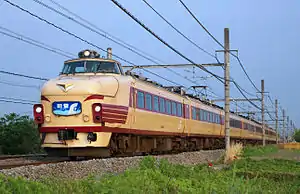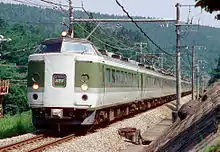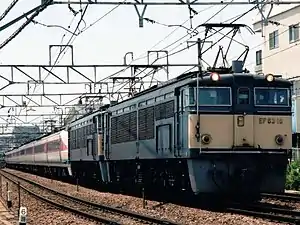489 series
The 489 series (489系, 489-kei) was a limited express electric multiple unit (EMU) train type introduced in March 1972 by Japanese National Railways (JNR) in Japan, and later operated by East Japan Railway Company (JR East) and West Japan Railway Company (JR-West) until 2012.[1]
| 489 series | |
|---|---|
 489 series on a Noto service in May 2007 | |
| In service | 1972–2012 |
| Constructed | 1971–1979 |
| Number in service | None |
| Number preserved | 2 vehicles |
| Operator(s) | JNR (1972–1987) JR East(1987–2000) JR-West (1987–2012) |
| Depot(s) | Kanazawa |
| Specifications | |
| Maximum speed | 120 km/h (75 mph) |
| Traction system | Resistor control |
| Electric system(s) | 1,500 V DC / 20 kV AC, 50/60 Hz |
| Current collector(s) | overhead catenary |
| Braking system(s) | Dynamic brake, electro-pneumatic brake |
| Safety system(s) | ATS |
| Track gauge | 1,067 mm (3 ft 6 in) |
Operations
The 489 series trains were developed from the earlier 485 series specially for use on the Hakusan and Asama limited express services operating over the steeply graded Usui Pass (Yokokawa Station - Karuizawa Station of old JNR Shinetsu Main Line). They were designed to operate in multiple with the JNR Class EF63 electric banking locomotives.[1]
 A 489 series EMU on an Asama service in August 1997
A 489 series EMU on an Asama service in August 1997 A 489 series EMU hauled by EF63 banking locomotives on an Hakusan service in June 1997
A 489 series EMU hauled by EF63 banking locomotives on an Hakusan service in June 1997
Formations
The nine-car sets operated by JR-West and based at Kanazawa depot for use on Noto and Hakutaka services were formed as shown below.[2]
| Car No. | 1 | 2 | 3 | 4 | 5 | 6 | 7 | 8 | 9 |
|---|---|---|---|---|---|---|---|---|---|
| Numbering | KuHa 489-500 | MoHa 488 | MoHa 489 | SaRo 489 | MoHa 488-200 | MoHa 489 | MoHa 488 | MoHa 489 | KuHa 489 |
| Facilities | Toilet | Phone / Toilet | Toilet | Lounge area | Toilet | ||||
Cars 2, 5, and 7 were each fitted with two lozenge-type pantographs.[2]
History
Following the end of regular Noto express services in March 2010, the three remaining JR-West 489 series sets based at Kanazawa depot lost their regular duties, and two sets were withdrawn in June and August of the same year.[3]
The remaining set, H01, was used on a special "Arigato" ("Thankyou") run between Osaka and Kanazawa on 26 and 27 March 2011, after which it was stored at Kanazawa depot.[4][5]
Set H01 was officially withdrawn on 1 June 2012.[6]
Preserved examples
- KuHa 489-1: Preserved at the Kyoto Railway Museum in Kyoto since April 2016.[7]
- KuHa 489-501: Preserved in Komatsu, Ishikawa (since March 2013)[8]
 KuHa 489-1 at the Kyoto Railway Museum in April 2016
KuHa 489-1 at the Kyoto Railway Museum in April 2016 KuHa 489-501 in Komatsu in August 2014
KuHa 489-501 in Komatsu in August 2014
References
- Jēāru zensharyō handobukku: Rail Magazine 2009 JR全車輌ハンドブック2009 [JR Rolling Stock Handbook 2009]. Japan: Neko Publishing. 2009. pp. 183–4. ISBN 978-4-7770-0836-0.
- JR電車編成表 '07冬号 [JR EMU Formations - Winter 2007]. Japan: JRR. December 2006. p. 134. ISBN 978-4-88283-046-7.
- ボンネット型、最後の走行 金沢から白山へ ["Bonnet style" makes last run from Kanazawa to Hakuzan]. The Hokkoku Shimbun (in Japanese). Japan. 16 May 2012. Archived from the original on 23 June 2012. Retrieved 30 August 2012.
- 「ありがとう489系」運転 ["Thankyou 489 series" run]. Japan Railfan Magazine Online (in Japanese). Japan: Koyusha Co., Ltd. 27 March 2011. Retrieved 30 August 2012.
- "489系H01編成が本線走行" [489 series H01 mainline run]. Japan Railfan Magazine Online (in Japanese). Japan: Koyusha Co., Ltd. 17 April 2012. Retrieved 30 August 2012.
- "JR車両のうごき" [JR Rolling Stock Changes]. Tetsudō Daiya Jōhō Magazine. 41 (341): 143. 2012.
- 京都鉄道博物館 [Kyoto Railway Museum]. Japan Railfan Magazine (in Japanese). Vol. 56, no. 662. Japan: Koyusha Co., Ltd. June 2016. p. 50.
- クハ489-501が,保存先の小松市へ陸送される [KuHa 489-501 moved to preservation site in Komatsu]. Japan Railfan Magazine Online (in Japanese). Japan: Koyusha Co., Ltd. 11 March 2013. Retrieved 12 March 2013.
